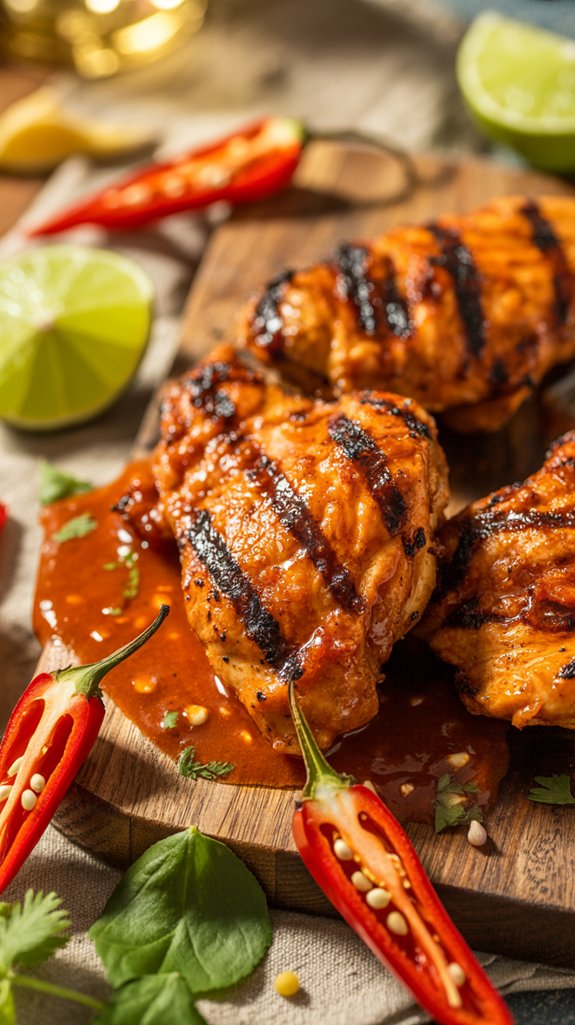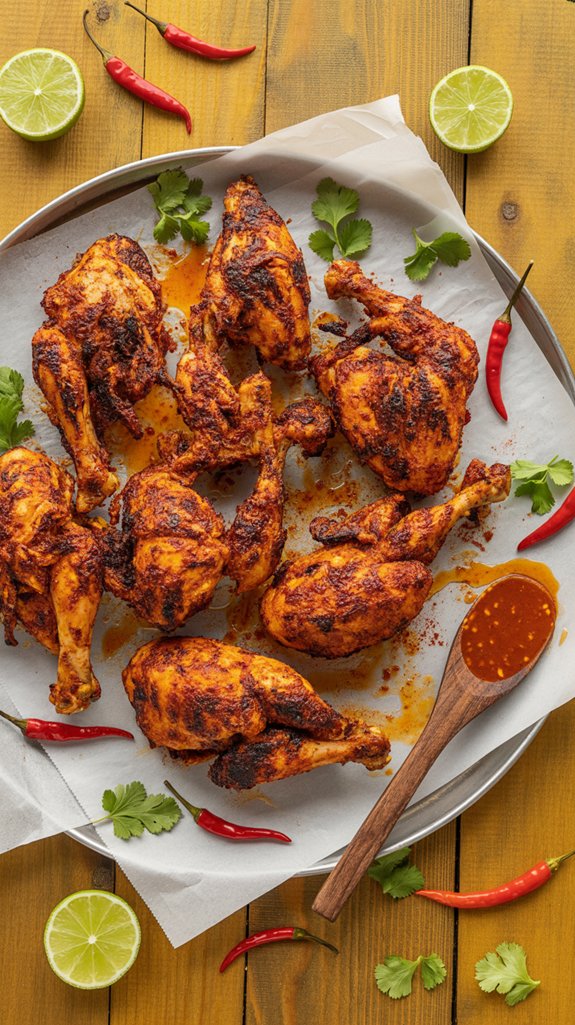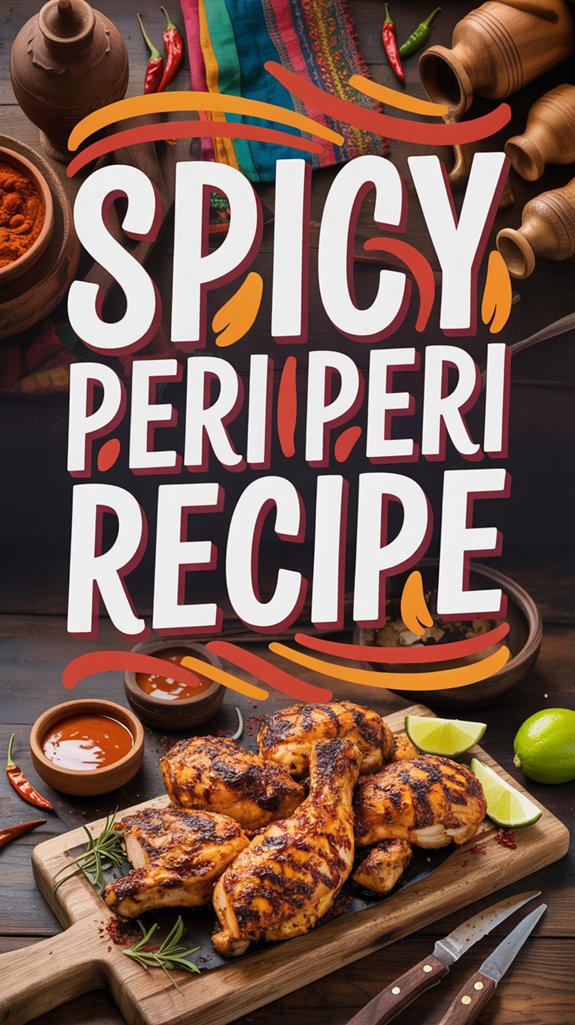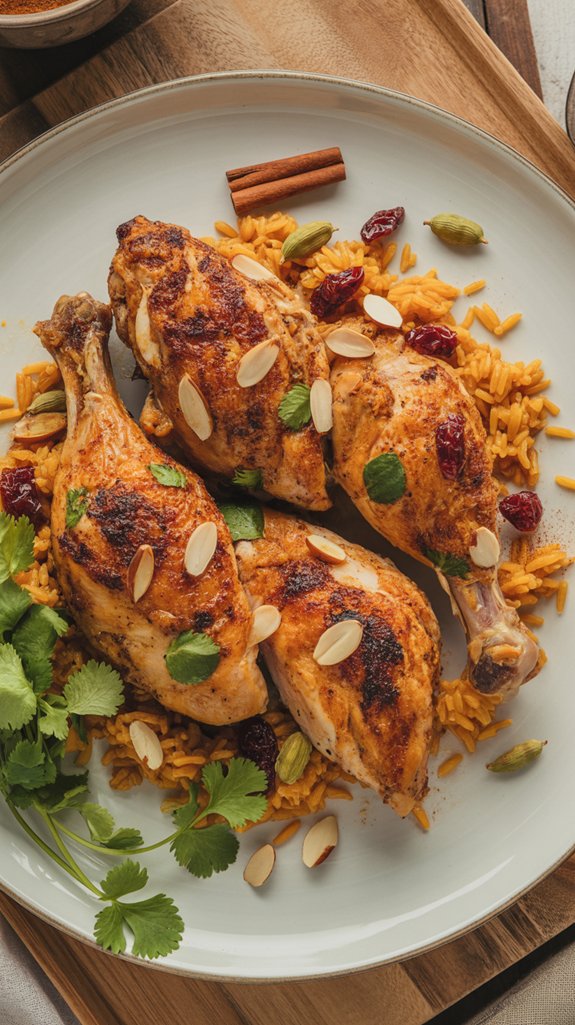Why You’ll Love This this Spicy African Peri Peri Chicken
This recipe brings serious heat with those dried chiles creating a paste that’s basically liquid fire in the best possible way.
The blend of aromatic spices like Chinese five spice and smoked paprika transforms ordinary chicken into something that tastes like it traveled straight from an African street market to your backyard grill.
You’ll get that perfect balance of spicy, smoky, and slightly sweet flavors that’ll have you wondering why you ever settled for plain grilled chicken in the first place.
Ingredients List
This peri peri paste is going to set your taste buds on fire, so let’s make sure you’ve got everything you need to create this spicy masterpiece.
- 2-3 lbs chicken
- 4 dried arbol chiles
- 1 dried ancho chile
- 3 tablespoons lemon juice
- 3 tablespoons water
- 1 tablespoon sea salt
- 1/2 tablespoon brown sugar
- 1/2 tablespoon smoked paprika
- 1/2 tablespoon Chinese five spice powder
- 1 teaspoon lemon pepper
- 1/4 teaspoon dried thyme
- 1 1/2 tablespoons olive oil
- 1/8 cup fresh onion, minced
- 1 tablespoon fresh garlic, minced
- 1 tablespoon fresh ginger, minced
- 1 tablespoon tomato paste
- 1 tablespoon peanut butter
- Fist full cilantro, chopped
- The good news is this recipe packs serious nutritional punch with fresh ginger and garlic working as natural anti-inflammatories
- Those dried chiles bring vitamin C and capsaicin, which can boost your metabolism
- The peanut butter adds protein and healthy fats, though it does bump up the calorie count a bit
- Fresh herbs like cilantro and thyme contribute antioxidants without any guilt
- Skip the brown sugar if you’re watching carbs, though you’ll lose that subtle caramelized sweetness
Step by Step Directions

This fiery peri peri chicken transforms simple ingredients into an intensely flavorful African-inspired dish that’ll have you coming back for more.
- Prepare the chiles: Simmer the 4 dried arbol chiles and 1 dried ancho chile in 3 tablespoons each of lemon juice and water for 10 minutes.
- Make the paste: Add the simmered chiles and all remaining ingredients except chicken to a food processor and blend until smooth paste forms.
- Marinate the chicken: Coat all 2-3 lbs of chicken pieces thoroughly with the paste and marinate for 15 minutes up to 24 hours.
- Cook the chicken: Grill using offset heat or bake in oven at 375°F until chicken reaches the deep color of Coca-Cola, approximately 1 hour.
- Check doneness: Verify internal temperature reaches 165°F before serving.
For restaurants serving this dish regularly, investing in quality commercial kitchen equipment ensures consistent results and efficient preparation of large batches.
Substitutions and Variations
- Craving extra heat? Add a fresh jalapeño or serrano pepper to the paste, or throw in a pinch of cayenne powder for that extra kick that’ll make you question your life choices.
- No fresh ginger? Ground ginger works in a pinch – use about 1 teaspoon instead of the tablespoon, since the dried stuff packs more punch per spoonful.
- Whole chicken feels like too much work? This paste works beautifully on chicken thighs, drumsticks, or even boneless breasts – just adjust your cooking time accordingly.
Additional Things to Serve With This Dish
This intensely flavorful chicken deserves sides that can either cool down the heat or complement those bold African spices.
- Portuguese rice or coconut rice – The creamy, mild flavors provide the perfect counterbalance to all that fiery peri peri goodness, and to be frank, you’ll need something to absorb all those amazing drippings.
- Grilled pineapple or mango slices – The natural sweetness cuts through the spice while adding a tropical atmosphere that makes perfect sense with African flavors.
- Simple cucumber salad with lime and mint – Sometimes you just need something cool and invigorating to reset your palate between bites of that gloriously spicy chicken.
- Roasted sweet potatoes or plantains – These bring out the earthier notes in the five spice and complement the smokiness from the paprika.
- Crusty bread or naan – Because you absolutely can’t let that incredible sauce go to waste, and bread is basically an edible napkin that tastes way better.
- Cold beer or a lime-mint agua fresca – Trust me, you’ll want something cold and invigorating on standby when that heat kicks in.
Cooking Tips & Tricks (Chef’s Notes)
A few insider secrets can make the difference between good peri peri chicken and the kind that makes you want to lick the plate when nobody’s looking.
- Don’t skip the marinating time – I know 15 minutes seems tempting when you’re hungry, but that extra time lets those chilies really penetrate the meat, and trust me, your taste buds will thank you for the patience.
- Pound the chicken pieces slightly before marinating – This creates more surface area for that gorgeous paste to cling to, plus it helps everything cook more evenly so you don’t end up with dried-out edges and raw centers.
- Save some of the paste for basting – Set aside about a quarter of your marinade before it touches the raw chicken, then brush it on during the last 10 minutes of cooking for that extra layer of flavor that makes restaurant-quality chicken.
- Use a meat thermometer, seriously – That “color of Coca-Cola” description is charming, but chicken thighs need to hit 165°F internal temperature, and dark, spicy marinades can look done way before they actually are.
- Let it rest for 5-10 minutes after cooking – I know it smells incredible and you want to plunge right in, but resting keeps all those juices from running out the second you cut into it.
- Double-check your spice tolerance – Arbol chilies don’t mess around, so if you’re sensitive to heat, maybe start with just 2-3 instead of the full 4, because there’s no going back once that paste is made.
Nutritional Facts
This protein-packed African classic delivers serious flavor alongside impressive nutritional benefits, making it a guilt-free indulgence that satisfies both your taste buds and your body’s needs.
- High in protein – A 4-oz serving provides approximately 35-40 grams of lean protein, essential for muscle building and repair.
- Rich in vitamin C – The lemon juice and chilies deliver a powerful antioxidant boost that supports immune system function.
- Contains capsaicin – The arbol and ancho chilies provide natural compounds that may boost metabolism and reduce inflammation.
- Good source of selenium – Chicken is naturally high in this mineral that supports thyroid function and acts as an antioxidant.
- Low in carbohydrates – Only about 3-4 grams of carbs per serving, making it keto and low-carb diet friendly.
- Provides healthy fats – The olive oil and peanut butter contribute beneficial monounsaturated fats for heart health.
- Contains iron and zinc – Essential minerals for energy production and immune system support.
- Approximately 280-320 calories per 4-oz serving – Varies depending on chicken cut and skin-on versus skinless preparation.
- Good source of B vitamins – Particularly niacin and B6, which support energy metabolism and brain function.
- Anti-inflammatory properties – Ginger, garlic, and chilies contain compounds that may help reduce inflammation in the body.
Fun “Did You Know?”
Beyond its impressive health benefits, peri peri chicken carries fascinating stories that’ll make you appreciate every spicy bite even more.
I’ve found that “peri peri” actually means “pepper pepper” in Swahili – talk about emphasis! Portuguese explorers first encountered these fiery African bird’s eye chilies in the 15th century, eventually spreading the recipe across their colonies.
Here’s what amazes me most: traditional peri peri sauce contains no tomatoes, unlike my fusion version. The authentic preparation uses only chilies, garlic, lemon, and oil.
Today, this humble African street food has conquered international restaurant chains worldwide.





